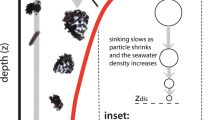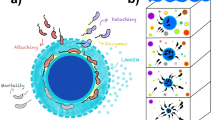Abstract
SETTLING particles are thought to be responsible for much of the transport of mass and energy from the upper ocean to the sea floor. Photosynthetic production by phytoplankton is a major source of these particles, either as phytoplankton biomass sinks directly1or as it is transformed into rapidly sinking forms such as aggregates2,3 and zooplankton faeces4. Because a variety of processes may act on sinking matter, however, it is not known to what extent fluxes of organic matter to the deep sea are coupled to processes at the ocean surface. Some studies have provided evidence for direct coupling2,5–7, but transformation processes and advection exist which have the potential to modify the transmission of surface signals to the deep sea8–11. If these mechanisms overwhelm surface production signals, seasonal and annual variations in deep-sea geochemistry and biology would be controlled largely by lateral processes associated with ocean circulation rather than by surface processes. Here we report direct measurements of seasonal variations in upper-ocean primary production concurrent with particle fluxes measured at several depths ranging from the upper to the deep ocean in the Atlantic. We find that the productivity signal can be transferred rapidly to the deep sea by settling particles, yielding close temporal coupling between the surface and deep oceans.
This is a preview of subscription content, access via your institution
Access options
Subscribe to this journal
Receive 51 print issues and online access
$199.00 per year
only $3.90 per issue
Buy this article
- Purchase on Springer Link
- Instant access to full article PDF
Prices may be subject to local taxes which are calculated during checkout
Similar content being viewed by others
References
Billett, D. S. M., Lampitt, R. S., Rice, A. L. & Mantoura, R. F. C. Nature 302, 520–522 (1983).
Alldredge, A. L. & Gotschalk, C. Limnol. Oceanogr. 33, 339–351 (1988).
Asper, V. L. Deep Sea Res. 34, 1–17 (1987).
Urrere, M. A. & Knauer, G. A. J. Plank. Res. 3, 369–387 (1981).
Deuser, W. G. & Ross, E. H. Nature 283, 364–365 (1980).
Deuser, W. G. Deep Sea Res. 33, 225–246 (1986).
Lohrenz, S. E. et al. Deep Sea Res. (in the press).
Karl, D. M., Knauer, G. A. & Martin, J. H. Nature 332, 438–441 (1988).
Michaels, A. F., Silver, M. W., Gowing, M. M. & Knauer, G. A. Deep Sea Res. 37, 1285–1296 (1990).
Gardner, W. D., Southard, J. B. & Hollister, C. D. Mar. Geol. 65, 199–242 (1985).
Honjo, S., Spencer, D. W. & Farrington, J. W. Science 216, 516–518 (1982).
Knauer, G. A. & Martin, J. H. Limnol. Oceanogr. 26, 181–186 (1981).
Fitzwater, S. E., Knauer, G. A. & Martin, J. H. Limnol. Oceanogr. 27, 544–551 (1982).
Knauer, G. A., Martin, J. H. & Bruland, K. W. Deep Sea Res. 26, 97–108 (1979).
Honjo, S. & Doherty, K. W. Deep Sea Res Res. 35, 133–149 (1988).
Honjo, S. J. Mar. Res. 36, 469–492 (1978).
Deuser, W. G., Ross, E. H. & Anderson, R. F. Deep Sea Res. 28, 495–505 (1981).
Jickells, T. D., Church, T. M. & Deuser, W. G. Global biogeochem. Cycles 1, 117–130 (1987).
Jickells, T. D., Deuser, W. G. & Belastock, R. A. Mar. Chem. 29, 203–219 (1990).
Honjo, S. Science 218, 883–884 (1982).
Izdar, E. et al. Naturwissenschaften 71, 478–479 (1984).
Deuser, W. G. Deep Sea Res. 37, 1331–1343 (1990).
Walsh, I., Fisher, K., Murray, D. & Dymond, J. Deep Sea Res. 35, 59–70 (1988).
Honjo, S., Manganini, S. J. & Cole, J. J. Deep Sea Res. 29, 609–625 (1982).
Honjo, S. J. Mar. Res. 38, 53–97 (1980).
Deuser, W. G., Muller-Karger, F. E. & Hemleben, C. J. geophys. Res. 93, 6857–6862 (1988).
Siegel, D. A., Granata, T. C., Michaels, A. F. & Dickey, T. D. J. geophys. Res. 95, 5305–5311 (1990).
Asper, V. L., Thesis, Woods Hole Oceanographic Institution, Massachusetts Institute of Technology (1986).
Brewer, P. G., Nozaki, Y., Spencer, D. W. & Fleer, A. P. J. Mar. Res. 38, 703–738 (1980).
Butman, C. A., J. Mar. Res. 44, 645–693 (1986).
Butman, C. A., Grant, W. D. & Stolzenbach, K. D. J. Mar. Res. 44, 601–644 (1968).
Gardner, W. D. J. Mar. Res. 38, 41–52 (1980).
Knauer, G. A. & Asper, V. L. (co chairs) US GOFS Planning Report Number 10, Sediment Trap Technology and Sampling (US JGOFS Planning Office, Woods Hole, 1989).
Author information
Authors and Affiliations
Rights and permissions
About this article
Cite this article
Asper, V., Deuser, W., Knauer, G. et al. Rapid coupling of sinking particle fluxes between surface and deep ocean waters. Nature 357, 670–672 (1992). https://doi.org/10.1038/357670a0
Received:
Accepted:
Issue Date:
DOI: https://doi.org/10.1038/357670a0
This article is cited by
-
Characterization of the negative carbon isotope shift in segment C2, its global implications as a harbinger of OAE1a
Science China Earth Sciences (2017)
-
Polysaccharide aggregation as a potential sink of marine dissolved organic carbon
Nature (2004)
-
Short term variability of Particle fluxes and its relation to variability in sea surface temperature and chlorophylla field detected by Ocean Color and Temperature Scanner (OCTS) off Sanriku, northwestern North Pacific in the spring of 1997
Journal of Oceanography (1998)
-
Carbon-cycle imbalances in the Sargasso Sea
Nature (1994)
-
The ocean as part of the global carbon cycle
Environmental Science and Pollution Research (1994)
Comments
By submitting a comment you agree to abide by our Terms and Community Guidelines. If you find something abusive or that does not comply with our terms or guidelines please flag it as inappropriate.



